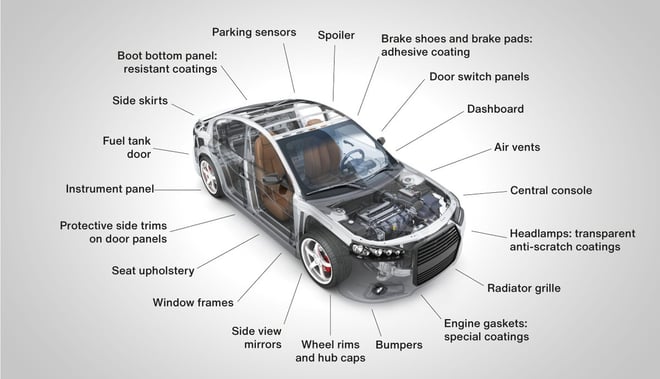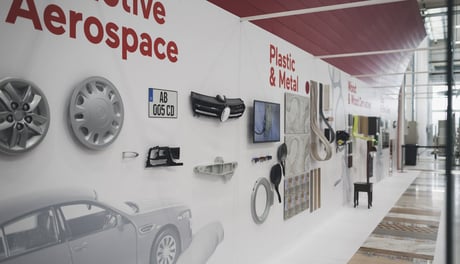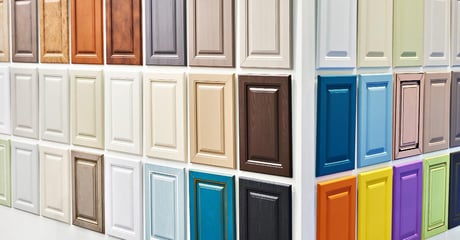
Painting car components requires machines and procedures able to combine innovation, efficiency and precision. Plastic parts are increasingly popular in the automotive industry and the finishing process should not only improve their perceived quality but also guarantee their durability over time. In this regard, being able to control the processing parameters with extreme precision and to perform completely automatic paint finishing is essential to optimise end results, regardless of whether the parts are inside or outside the passenger compartment.
What are the available coating techniques for automotive parts?
Usually, finishing of car parts and components is done by spray coating on overhead lines. However, there are also systems that allow parts to be processed at ground level, inside painting booths with horizontal air flow integrated with chain conveyors and anthropomorphic robots with point-to-point programming.

Then there are finishing lines known as flatbed lines. These use a different approach: parts placed on supporting jigs (which are not fixed to the line in the solution designed by Cefla) that lie on a horizontal conveyor while being painted.
Thanks to a conveyor belt and a vertical air flow blowing from top to bottom, this solution drastically improves end product quality. The machines of the most advanced lines are also able to detect the shape and position of the parts and, consequently, process them without requiring any specific programming.
Importance of lacquer and paint quality
Vertical spray coating lines are best suited to larger parts, such as bumpers.
Smaller parts - generally used in the passenger compartment and therefore requiring flawless precision and quality - are instead ideally processed on flatbed lines. In addition to ensuring greater productivity, flatbed lines also allow output efficiency to be improved - thanks to the machinery's ability to minimise defects caused by overspray, as the special machine architecture allows any overspray to be removed from the bottom.
The flatbed line proposed by Cefla Finishing, for instance, ensures up to 20% more productivity than other solutions, guaranteeing an excellent quality glossy piano black finish, ideal for parts designed for key dashboard sections and for the internal finishing of car doors.
This kind of performance is also achieved through partnerships that Cefla has initiated with several paint suppliers: in-depth knowledge of the technical characteristics of the best products available on the market allows production lines to be configured with the greatest precision, so as to optimise the consumption and efficiency of all the paint types used.

THE MOST INNOVATIVE FINISHING SOLUTIONS
Discover how highly advanced finishing solutions can enhance your competitiveness.
The steps required to paint automotive parts
It is thanks to this approach that the benefits we offer to customers in terms of quality, productivity and cost-effectiveness are easily measurable throughout the value chain. For each type of processing, Cefla Finishing develops bespoke techniques, solutions and processes.
When it comes to coating car components, a high efficiency line should include, based on our expertise, the following steps:
- Surface preparation: automatic cleaning with carbon dioxide snow and deionisation with our Mito oscillating spray coater.
- First coat application: Parts are fed through a digital 2D or 3D reading barrier to the iBotic Cartesian spraying robot for (usually black) paint coating.
- First drying: the painted parts are moved to the Omnidry vertical oven for a 20-30 minutes' hold time.
- Second coat application: a new coat of clear lacquer is applied, possibly double-cured using UV rays, again by a iBotic Cartesian spraying robot.
- Final drying: Omnidry oven hold time of 45 minutes at 70°C then UV oven (UV-R M2) drying to increase the surface hardness of the paint coat.
Painting of internal parts
Any solutions should be adapted to the type of product to be painted. When it comes to a car’s internal components (listed below), the main priority is to obtain a finish that ensures the best result in terms of aesthetics and excellent durability of the materials.
- control panel
- dashboard
- air vents
- central console
- door panels and controls
- car seat upholstery
- boot bottom panel (highly resistant coating)
Coating of external parts
As for external parts, quality coating must guarantee, in addition to a pleasant surface feel, a layer of protection against weathering and minor impacts.
- door protector strips
- wheel rims
- wheel covers
- brake shoes and brake pads (adhesive coating)
- radiator grille
- window frames
- side view mirrors
- headlamps: transparent scratch-resistant coating
- fuel tank door
- parking sensors
- spoilers
- bumpers
- side skirts
- engine gaskets (special coating)
Automation in the paint finishing process for automotive parts
The painting process of parts and components in the automotive sector is particularly effective when integrated and automated lines are used. We are referring to complete, turnkey solutions, which in addition to robots and drying ovens also include, for example, dry ice cleaning equipment, capable of minimising the environmental impact.
Automation is also essential for smart, efficient handling of parts that require multiple coats of paint. To rise to this challenge, users can now rely on specially designed line software such as cTracker, a line monitoring tool developed by Cefla Finishing that automatically regulates painting operations and sets the correct temperatures for the drying phase. Each component can thus receive the most suitable treatment without any need to slow down or stop production.
The platform also monitors the parts on the line, records data and analyses performance in terms of productivity. Thanks to these advanced features, it is possible to implement production changes without having to empty the line, tracking and managing individual parts and adjusting all the machines from a single control point.
The adoption of integrated lines, especially of the flatbed type, ultimately represents a strategic choice for companies aiming to position themselves on the automotive market as cutting-edge players, achieving a competitive edge thanks to superior production performance and excellent quality levels.
LOOKING FOR THE IDEAL COATING LINE SOLUTION?








